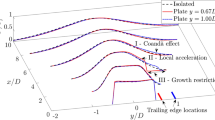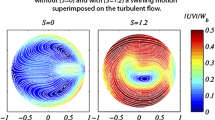Abstract
This paper describes measurements undertaken on an isothermal facility to study the effects of acoustic excitation on the flow field issuing from gas turbine style fuel injectors. The highly swirling and turbulent flow field is excited with plane acoustic waves generated by loudspeakers. Emphasis is placed on the accuracy of the measured response, over the range of excitation frequencies (50–1,500 Hz), and its possible contamination by the background turbulence. Simulated data are used to assess the experimental accuracy and the established errors, using this technique, are compared with an example set of results.










Similar content being viewed by others
Abbreviations
- C :
-
Coherence
- D :
-
Injector diameter
- f :
-
Frequency
- G :
-
Power spectral coefficients
- H :
-
Frequency response function
- ΔP :
-
Pressure drop across fuel injector (time averaged)
- p′ac :
-
Acoustic fluctuating (rms) pressure
- r :
-
Radius
- Tu:
-
Turbulence intensity (u′/U)
- U :
-
Velocity (time averaged)
- u′ex :
-
Fluctuating (rms) velocity response to applied excitation
- u′ac :
-
Acoustic fluctuating (rms) velocity
- u′qs :
-
Fluctuating (rms) quasi-steady velocity (Eq. 1)
- u′sim :
-
Simulated fluctuating (rms) velocity
- X :
-
Axial coordinate
- HWA:
-
Hot wire anemometer
- 1:
-
Reference pressure signal
- 2:
-
Velocity signal
References
Anderson TJ, Kendrick DW, Cohen JM (1998) Measurement of spray/acoustic coupling in gas turbine fuel injectors. AIAA Paper 98-0718, 36th AIAA Aerospace sciences meeting and exhibit
Biron D, Simon F (2002) Characteristics of acoustic sources. Muscles report, Onera
Bruun H (1995) Hot wire anemometry. Oxford University Press, New York
Crow SC, Champagne FH (1971) Orderly structure in jet turbulence. J Fluid Mech 48(3):547–591
Eckstein J, Freitag E, Hirsch C, Sattelmayer T (2003) Forced low frequency spray characteristics to a generic airblast swirl diffusion burner. ASME-GT-2003-38646
Ho CM, Heurre P (1984) Perturbed free shear layers. Ann Rev Fluid Mech 16:365–424
Kroeff G, Carrotte J (2002) Fuel injector studies. Department of Aero Engineering, Loughborough University, UK, University Research Paper TT02R05
Lynn PA (1982) An introduction to the analysis and processing of signals. Macmillan, London
Marrot F, Simon F, Gajan P, Pauzin S (2000) Active control of a backward-facing step flow. AIAA/CEAS Aeroacoustics conference and exhibit, AIAA-2000-1929
Paschereit CO, Wygnanski I, Fiedler HE (1995) Experimental investigation of subharmonic resonance in an axisymetric jet. J Fluid Mech 283:365–407
Seybert AF, Soenarko B (1981) Error analysis of spectral estimates with application to the measurement of acoustic parameters using random sound fields in ducts. J Acoust Soc Am 69(4):1190–1199
Shadow KC, Wilson KJ, Gutmark E (1987) Characterisation of large-scale structures in a fored ducted Dflow with dump. AIAA J 25(9):1164–1170
Taghavi R, Rice EJ, Farokhi S (1988) Controlled excitation of a cold turbulent swirling free jet. J Vib Acoust Stress Reliability Des Trans ASME110:234–237
Zhu M, Dowling AP, Bray KNC (2001) Self excited oscillations in combustors with spray atomizers. Trans ASME J Eng Gas Turbines Power 123:779–786
Acknowledgements
The authors would like to acknowledge the financial support of the European Union under the MUSCLES framework 5 programme (contract number GRD1-2001-40198). In addition the authors would also like to acknowledge the advice of Alex Riley and Jeff Eldridge (formerly of Cambridge University) for advice on using the two-microphone technique along with some example software.
Author information
Authors and Affiliations
Corresponding author
Rights and permissions
About this article
Cite this article
Barker, A., Carrotte, J. & Denman, P. Analysis of hot-wire anemometry data in an acoustically excited turbulent flow field. Exp Fluids 39, 1061–1070 (2005). https://doi.org/10.1007/s00348-005-0039-z
Received:
Revised:
Accepted:
Published:
Issue Date:
DOI: https://doi.org/10.1007/s00348-005-0039-z




